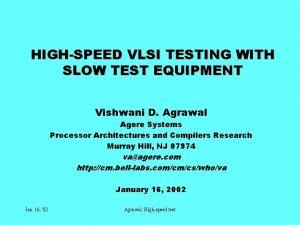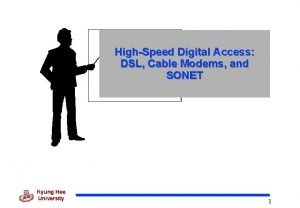HighSpeed CCDs for optical and NIR astronomy Fully

- Slides: 1

High-Speed CCD`s for optical and NIR astronomy Fully depleted silicon pn. CCD`s, developed for the XMM/NEWTON and DUO missions, exhibit high quantum efficiencies from the near infrared to the vacuum UV region due to their large sensitive volume of 500 mm thickness and a homogeneous and ultrathin radiation entrance window. The multiparallel readout allows for frame rates higher than 1 k. Hz for a device having a format of 264*264 pixel and a pixel size of 50 mm. An electronic noise contribution of less than 3 electrons (rms) was achieved at an operting temperature of -80 o. C. The high speed, low noise and high quantum efficiency makes these devices especially suited for the use as wavefront sensors in adaptive optics systems. Back-illuminated pn-CCD’s have been developed at the semiconductor laboratory of the Max. Planck-Institut für extraterrestrische Physik over the past years as X-ray sensitive imaging detectors. Many outstanding characteristics of these X-ray devices, as their high intrinsic quantum efficiency of more than 90% within the entire energy range between 300 e. V an 10 ke. V and their exceptionally low readout noise of less than 3 electrons (rms), make them as ideal detectors in the optical region as well. Measurements of the internal quantum efficiency from the vacuum UV (VUV) to near infrared (NIR) region have revealed nearly 100% within the entire range. With an integration of antireflective coatings, the detector response can be optimized for any desired wavelength range. CCD‘s with pixel sizes between 50 mm and 150 mm have been build. The left picture below shows a device with 50 mm pixel size and an image area containing 128*256 pixel. Located underneath the CCD are 2 amplification and readout chips (CAMEX) for a parallel amplification of an entire CCD line at once. A frame-rate of 500 frames per second was achieved without loss in noise performance. To the right, a schematic drawing of a double-side readout CCD, currently in production, is shown. Parallel to developments in order to improve the detector performance are developments in readout and data acquisition electronics. Operating a 264*264 CCD at 1000 frames per second generates a constant data flow of 140 MByte/s. Electronic subcomponents with integrated data correction and data reduction routines are also currently under development. References: • R. Hartmann, K. -H. Stefan and L. Strüder, Nucl. Instr. And Meth. A 439 (2000) 216 -220 • N. Meidinger et al. , Nucl. Instr. And Meth. A 512 (2003) 341 -349 MPI Semiconductor Laboratory, PNSensor and FZ Jülich

